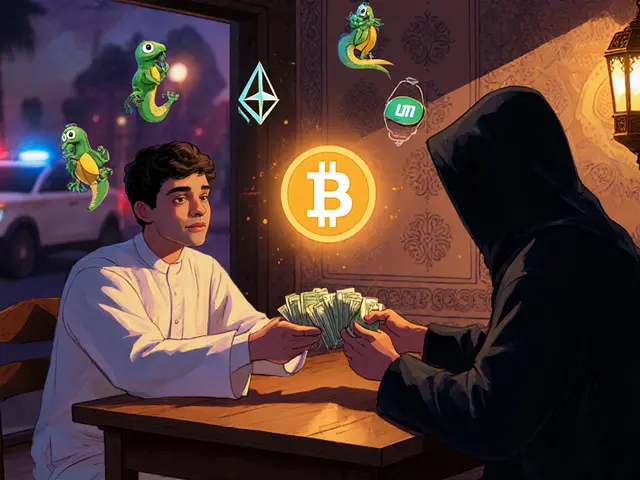Remittance Cost Calculator
Send money to family in Ecuador? Traditional remittance services charge 6.3% fees. Crypto-based remittances using OTC traders typically charge 5-7%. Calculate your savings.
Results
Enter an amount to see savings.
Note: Crypto remittances in Ecuador use peer-to-peer platforms like Binance P2P or Mercado Bitcoin. You'll need to meet an OTC trader in person. While you may save on fees, there are risks including scams (23% of users report being scammed) and potential account freezes if banks detect transactions to crypto platforms.
If you live in Ecuador and want to buy Bitcoin or send crypto to family abroad, you’re not breaking the law-but you’re fighting an uphill battle. The government hasn’t banned cryptocurrency outright, but it’s made it nearly impossible to use it legally. Banks block transfers. Exchanges are blacklisted. And the only official currency? The US dollar. This isn’t a free market. It’s a system designed to keep digital money out-no matter how many people need it.
What’s Actually Legal in Ecuador?
You can own Bitcoin. You can buy Ethereum. You can hold it in a wallet. The Central Bank of Ecuador says this clearly: cryptocurrencies are not legal tender. That means you can’t pay for groceries with Bitcoin at the supermarket. But nowhere does it say you can’t buy or sell it privately. That’s the gray zone. People do it anyway. Thousands of Ecuadorians use peer-to-peer platforms like Mercado Bitcoin or Binance P2P to trade crypto for cash. It’s not official. It’s not protected. But it’s happening.
Here’s the catch: your bank will freeze your account if they catch you sending money to a crypto exchange. One Reddit user in Quito reported three bank accounts frozen in one year after trying to buy crypto. That’s not rare. Banks are legally required to block any transaction linked to digital assets. They don’t need proof-just suspicion. If your transfer goes to Binance, OKX, or even a Telegram OTC desk, it gets flagged. And once flagged, your money vanishes.
Who’s in Charge? The Four Bodies That Control Crypto in Ecuador
There’s no single crypto law. Instead, four government agencies work together to shut it down quietly.
- Central Bank of Ecuador (BCE): The main enforcer. They’ve issued warnings in 2021, 2023, and again in August 2024. Their message? “Cryptocurrencies aren’t money here. We won’t protect you.” They also run the failed electronic money system “Dinero Electronico,” which only 0.5% of people use.
- Monetary and Financial Policy and Regulation Board (JPRM): They’ve passed resolutions since 2022 explicitly banning crypto as a payment method. No loopholes here.
- Superintendency of Banks (SB): They keep a public list of unauthorized crypto platforms. Every major exchange is on it. If you use one, you’re technically violating banking rules-even if you’re just buying Bitcoin for yourself.
- Internal Revenue Service (SRI): This is the only body that treats crypto like real income. If you sell Bitcoin for a profit, you owe taxes. Individuals pay up to 35%. Companies pay 25%. No one reports it. But if you get audited? You’re on the hook.
So you can own crypto. But if you try to move it through the banking system, you’ll get blocked. If you make money from it, you’re supposed to pay taxes. But no one checks. That’s the reality.
Why Is Adoption So Low? Only 2.73% of Ecuadorians Own Crypto
Latin America has one of the highest crypto adoption rates in the world-10.9% on average. Ecuador? Just 2.73%. That’s 500,000 people out of 18 million. Why?
First, only half of adults have a bank account. That means most people can’t even access the system to buy crypto in the first place. Second, electricity is expensive-$0.145 per kWh, 23% higher than the regional average. Mining? Forget it. The grid crashes 14.7 hours a month on average. Even if you could afford a mining rig, the power cuts make it useless.
Third, importing hardware is a nightmare. You pay 35% in import taxes just to bring in a single ASIC miner. Most people can’t afford that. So mining is limited to a few basement setups in Quito and Guayaquil. Total hash rate? Less than 0.0001% of the global network. It’s practically invisible.
And then there’s the fear. People know their bank can freeze their account. They’ve seen it happen. So they wait. Or they use risky OTC traders-cash-for-crypto deals in parking lots or cafes. One user on Reddit said he did 12 trades totaling $1,500 with no issues. But 23% of Ecuadorian crypto users report being scammed. The premiums are high too-8-12% above global prices just to get cash in hand.

Remittances: The Real Reason People Want Crypto
Ecuador receives $3.8 billion in remittances every year-8.5% of its entire GDP. Most of it comes from family in the U.S. Sending it through Western Union or MoneyGram? You pay 6.3% in fees. That’s $240 million wasted every year.
That’s why crypto is so tempting. Someone in Miami sends $500 in USDT. The recipient in Guayaquil meets a local OTC trader, hands over cash, and gets the equivalent in local currency. No bank. No fees. No waiting. But it’s risky. No contracts. No recourse if the trader disappears. And the trader charges 5-7% just to make the swap.
According to a 2024 survey, 68% of Ecuadorian crypto users say they receive crypto from family abroad. That’s not speculation. That’s survival. But the government doesn’t see it that way. They see a threat to dollarization-not a lifeline for the unbanked.
How Ecuador Compares to Neighbors
Neighboring countries are moving forward. Mexico has had a fintech law since 2018 that licenses crypto exchanges. Peru now requires all crypto businesses to register with its financial intelligence unit. Paraguay passed a law in 2022 that lets people use Bitcoin as payment and even mine it legally.
Ecuador? Nothing. No licenses. No rules. No protection. Just a wall.
Some experts say this is about control. In late 2023, Ecuador saw $1.2 billion in unexplained capital leaving the country. The Central Bank blames crypto. But the real issue? A weak economy and distrust in banks. People aren’t fleeing because of Bitcoin. They’re fleeing because they can’t trust the system-and crypto is the only tool that works.

What’s Next? CBDCs and the Future of Crypto in Ecuador
The Central Bank has been quietly working on a digital dollar-what’s called a Central Bank Digital Currency (CBDC). It would be 1:1 backed by the U.S. dollar. No blockchain. No decentralization. Just a digital version of cash controlled by the state.
Why? Because they want to modernize payments without giving up control. A CBDC could replace cash, cut remittance costs, and reach the unbanked-all while keeping the government in charge.
But here’s the irony: if they build this system, they’ll be creating the exact infrastructure that crypto users already want. The only difference? You won’t own it. The bank will.
Analysts are split. Some say regulation will come by 2026. Others say the BCE will hold firm until at least 2027. The truth? Change won’t come from public pressure. It’ll come when the cost of blocking crypto outweighs the fear of losing control.
How to Use Crypto in Ecuador Right Now
If you’re determined to use crypto, here’s what you need to know:
- Use P2P platforms: Binance, OKX, and Mercado Bitcoin allow cash trades. Avoid bank transfers. Meet in person or use trusted OTC desks.
- Never use your bank account: Any transfer to an exchange will be blocked-and your account may be frozen.
- Pay taxes if you sell: Even if no one checks, you’re legally required to report gains. Keep records.
- Be careful with OTC traders: Only deal with people recommended by local crypto Telegram groups or Reddit. Check their history.
- Use a hardware wallet: Don’t leave crypto on exchanges. Store it offline. Your bank can’t touch it if it’s not in their system.
There’s no easy way. But there is a way. It’s just not the one the government wants you to take.
Where to Get Help
There’s no official government guide. No help desk. No hotline. Your only resources are:
- Telegram groups: 15 active groups in Ecuador, each with 500-2,000 members. Search for “Crypto Ecuador” or “P2P Ecuador.”
- r/CryptoEcuador: The only active subreddit with 1,247 members. Real stories. Real warnings.
- YouTube: Only three Spanish channels in Ecuador have more than 5,000 subscribers. Combined, they have 28,000 viewers.
Most international crypto sites don’t even mention Ecuador. Their support articles assume you can use a bank. You can’t. You’ll need to figure it out yourself.
Is it illegal to buy Bitcoin in Ecuador?
No, it’s not illegal to buy, hold, or sell Bitcoin in Ecuador. The Central Bank says it’s not legal tender, but it doesn’t ban private transactions. The problem isn’t the law-it’s the banking system. Banks are forced to block all crypto-related transfers, making it hard to fund your purchases. You can still buy crypto through peer-to-peer platforms using cash, but your bank account will likely freeze if you try to send money directly to an exchange.
Can I use crypto to pay for goods or services in Ecuador?
No. The government explicitly prohibits using cryptocurrencies as a payment method. Businesses that accept Bitcoin or Ethereum risk penalties from the Superintendency of Banks. Even if a shop says they take crypto, they’re likely converting it to cash immediately through an OTC trader. There are no official crypto payment processors operating in Ecuador.
Do I have to pay taxes on crypto profits in Ecuador?
Yes. The Internal Revenue Service (SRI) treats crypto gains as taxable income. If you sell Bitcoin for a profit, you owe taxes-up to 35% for individuals and 25% for businesses. While enforcement is rare, you’re still legally required to report these gains. Keep records of all purchases and sales. If you’re audited, you’ll need proof of your transactions.
Why can’t I use my debit card to buy crypto in Ecuador?
Ecuadorian banks and card processors are legally required to block any transaction linked to cryptocurrency exchanges. Card acquirers classify crypto platforms as high-risk, so purchases are automatically declined. Even if you try to buy Bitcoin through a third-party app, the payment will be rejected. Your only option is peer-to-peer trading with cash or bank transfers that bypass the formal system-though those carry their own risks.
Is cryptocurrency mining allowed in Ecuador?
Mining isn’t explicitly banned, but it’s practically impossible. Electricity costs are among the highest in Latin America-$0.145 per kWh-and the grid suffers 14.7 hours of outages per month. Importing mining equipment also triggers a 35% tax. Most mining is done by individuals in small setups in Quito or coastal areas, but it’s not profitable at scale. There are no commercial mining operations in Ecuador.
Will Ecuador ever legalize cryptocurrency?
It’s possible-but not soon. The Central Bank is focused on launching a digital dollar (CBDC), which would give them control over digital payments without allowing private cryptocurrencies. Industry analysts predict regulatory changes by 2026 due to pressure from remittance businesses and fintech startups. But the BCE has shown no sign of backing down. Until then, crypto will remain in a gray zone-used by those who need it, but never officially recognized.










12 Comments
So let me get this straight-you’re telling me Ecuadorians are risking bank freezes to send crypto like it’s some underground resistance? Meanwhile, my bank lets me buy Dogecoin with my coffee money. This isn’t a revolution. It’s a glitch in the matrix.
I live in the U.S. and I still find this insane. Imagine having to meet someone in a parking lot just to get your own money. No one’s talking about how this crushes dignity. People aren’t doing this for fun-they’re doing it because the system broke. And now they’re being treated like criminals for trying to survive. I’ve seen families split by remittance fees. This isn’t policy. It’s cruelty dressed up as control.
It’s funny how the state fears crypto because it’s decentralized… but then builds a CBDC that’s even more centralized. The irony is thick enough to spread on toast. They’re not protecting the dollar-they’re protecting their own power. Crypto doesn’t threaten the economy; it exposes how broken the system already is. The real question isn’t whether Ecuador will legalize it-it’s whether they’ll ever admit they’ve been fighting the wrong enemy.
The fact that 68% of crypto users in Ecuador receive remittances via crypto tells you everything. This isn’t speculative investing-it’s lifeline economics. When your family sends money from Miami and you get it in 10 minutes instead of 3 days with 6% fees, you don’t care about legal tender. You care about your kid eating. The government’s obsession with control ignores the most basic human need: access. A CBDC might look modern, but if it doesn’t give people ownership, it’s just digital serfdom.
Let’s contextualize this: Ecuador’s crypto adoption rate is 2.73%-but in countries with similar GDP per capita and banking access, it’s over 8%. The gap isn’t technological. It’s institutional. The BCE’s fear of capital flight is valid, but their response is like locking the barn after the horse has already crossed three borders. The real capital flight is trust-people are fleeing the banking system, not the country. And crypto is just the vehicle.
People just want to send money home without getting robbed. That’s it. No drama. No ideology. Just survival.
It is imperative to note that the regulatory vacuum in Ecuador constitutes a systemic failure in financial inclusion. The absence of formalized crypto frameworks not only impedes economic modernization but also exposes the unbanked population to predatory OTC actors. The Central Bank's resistance to innovation, while ostensibly aimed at preserving monetary sovereignty, paradoxically exacerbates financial fragility. A structured regulatory sandbox, aligned with FATF guidelines, would mitigate risks while enabling access. The CBDC, if designed with interoperability and user sovereignty in mind, may serve as a bridge-not a barrier.
They’re lying. 🤫 The Central Bank is working with the IMF to crush crypto so they can push the CBDC-and then track every single transaction. They already know who you are. They already know how much you have. They’re building a digital prison and calling it ‘progress.’ The OTC traders? They’re just the front door. The real trap is the digital dollar. Don’t fall for it. 🚨
So Ecuadorians are risking their bank accounts to avoid paying fees… but they’re fine with paying 12% premiums to strangers in parking lots? That’s not freedom. That’s stupidity. If you can’t trust your government, why trust some guy on Telegram who might be a scammer? The dollar is stable. The system is broken-but crypto isn’t the fix. It’s the symptom. Get a real job. Stop gambling.
I love how people say ‘it’s not illegal’ like that makes it okay. But if your bank freezes your account for doing something that’s technically legal, then the law doesn’t matter-it’s the bureaucracy that rules. And that’s worse. It’s not about Bitcoin. It’s about who gets to decide what’s possible. The government’s not protecting the dollar. They’re protecting their own irrelevance.
From a fintech architecture standpoint, the Ecuadorian model represents a classic case of regulatory capture: institutional inertia masquerading as prudence. The absence of licensing frameworks for P2P platforms creates asymmetric risk exposure for end-users, while the SRI’s tax enforcement remains unenforced due to resource constraints-resulting in a de facto regulatory arbitrage environment. The CBDC, if implemented with zero-knowledge privacy protocols and non-custodial wallet integration, could resolve the trust deficit without compromising monetary policy. Absent such design principles, it will merely replicate the failures of the current system.
So the government bans crypto… but still taxes your profits? That’s like banning a restaurant, then charging you for eating there. The whole thing is a farce. They don’t want you using crypto. They just want you to pay them for using it. And they’re too lazy to build a real system. So they just sit there, blocking transfers and pretending they’re in charge. Meanwhile, people are trading cash for USDT in gas station parking lots like it’s 1992.